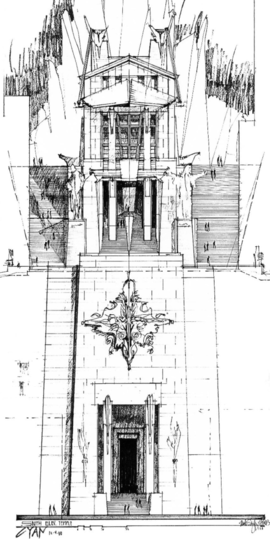Regeltovokum: Difference between revisions
(edited citation formatting) |
(illustration) |
||
| Line 4: | Line 4: | ||
| location = [[D'ni]] | | location = [[D'ni]] | ||
| dni-name = geltovoKum | | dni-name = geltovoKum | ||
| image = Temple-south-elevation.png | |||
| imagecaption = Artist's rendition of the temple's entrance. | |||
}} | }} | ||
Construction of the '''Temple of Yahvo''' started in [[48 DE]] and ended in [[63 DE]], along the [[Great Zero]].<ref>DRC. ''[[Reference:DRC_research_notebooks/King_Ri'neref|King Ri'neref Notebook]].'' [[Uru: Ages Beyond Myst]].</ref> It was dedicated by King [[Ri'neref]] to the [[Regeltavok Oorpah]], and was the first religious building built in [[D'ni]]. | Construction of the '''Temple of Yahvo''' started in [[48 DE]] and ended in [[63 DE]], along the [[Great Zero]].<ref>DRC. ''[[Reference:DRC_research_notebooks/King_Ri'neref|King Ri'neref Notebook]].'' [[Uru: Ages Beyond Myst]].</ref> It was dedicated by King [[Ri'neref]] to the [[Regeltavok Oorpah]], and was the first religious building built in [[D'ni]]. | ||
Revision as of 16:57, 6 May 2022
| This article is a stub. You can help the Archive by expanding it. |
 Artist's rendition of the temple's entrance. | |
| Name in D'ni | geltovoKum |
|---|---|
| Location | D'ni |
Construction of the Temple of Yahvo started in 48 DE and ended in 63 DE, along the Great Zero.[1] It was dedicated by King Ri'neref to the Regeltavok Oorpah, and was the first religious building built in D'ni.
There were delays with the construction plans because of disagreements regarding the specifics; the King lived in a nondescript house until it was finished, refusing to have a palace while Yahvo had none.
The temple was a place of worship, but also a reminder of the prophesied Great King foreseen by Oorpah. It originally contained the golden throne of the King of D'ni, until it was moved by King Ja'kreen to the newly-built Temple of the Great King in 643.[2]
By the time of King Me'erta, the religion of Yahvo was in decline and the Temple was mostly empty,[3] but became popular again under the influence of Tevahr: in [[3112 DE|3112] King Rakeri announced plans for renovations, taking advantage of a new extruding technology, and was completed in 3123.[4]
Fahlee, the great painter of the D'ni Renaissance, painted his final masterpiece for the inside of the Temple. King Kedri did further additions.[5]